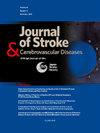Direct oral anticoagulants compared to aspirin for embolic stroke of undetermined source: A comprehensive meta-analysis
IF 2
4区 医学
Q3 NEUROSCIENCES
Journal of Stroke & Cerebrovascular Diseases
Pub Date : 2025-02-06
DOI:10.1016/j.jstrokecerebrovasdis.2025.108256
引用次数: 0
Abstract
Background
The use of anticoagulation for stroke prevention in embolic stroke of undetermined source (ESUS) is hypothesized to be beneficial over conventional antiplatelet use. However, randomized controlled trials (RCTs) have not found clear benefits, even when assessing cardioembolic enriching features. This study aimed to perform a meta-analysis exploring the efficacy and safety of direct oral anticoagulants (DOACs) following ESUS.
Methods
PubMed, Scopus, and Cochrane Central were systematically searched for studies comparing DOACs versus aspirin after ESUS. The primary outcome was stroke recurrence, and the safety outcome was major bleeding. A random-effects model was used for the analyses. Statistical analysis was performed using Review Manager Web 8.0.0 (RevMan Web).
Results
14,582 patients were included from 9 studies, of which 4 were RCTs. 7,341 (50.3 %) received DOACs as secondary prevention. For stroke recurrence, there was noted non-statistically significant trends towards benefit for DOACs (OR 0.93; 95 % CI 0.81–1.06; p = 0.29; I² = 34 %). No differences were found for major bleeding (HR 1.57; 95 % CI 0.86–2.86; p = 0.15; I² = 63 %). Among the atrial cardiomyopathy subgroup, no benefit was observed (OR 0.88; 95 % CI 0.50–1.55; p = 0.67; I² = 39 %).
Conclusion
There is insufficient evidence to recommend the use of DOACs over aspirin following ESUS for the prevention of stroke recurrence. Nevertheless, the fears of increased bleed risks were also not seen. Further efforts should be directed towards identifying potential embolic sources and the population that benefit from OAC.
求助全文
约1分钟内获得全文
求助全文
来源期刊

Journal of Stroke & Cerebrovascular Diseases
Medicine-Surgery
CiteScore
5.00
自引率
4.00%
发文量
583
审稿时长
62 days
期刊介绍:
The Journal of Stroke & Cerebrovascular Diseases publishes original papers on basic and clinical science related to the fields of stroke and cerebrovascular diseases. The Journal also features review articles, controversies, methods and technical notes, selected case reports and other original articles of special nature. Its editorial mission is to focus on prevention and repair of cerebrovascular disease. Clinical papers emphasize medical and surgical aspects of stroke, clinical trials and design, epidemiology, stroke care delivery systems and outcomes, imaging sciences and rehabilitation of stroke. The Journal will be of special interest to specialists involved in caring for patients with cerebrovascular disease, including neurologists, neurosurgeons and cardiologists.
 求助内容:
求助内容: 应助结果提醒方式:
应助结果提醒方式:


